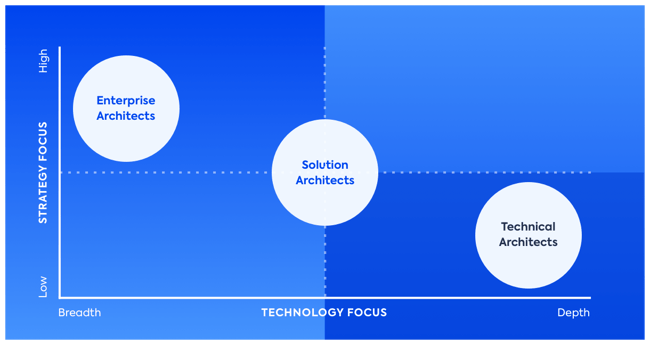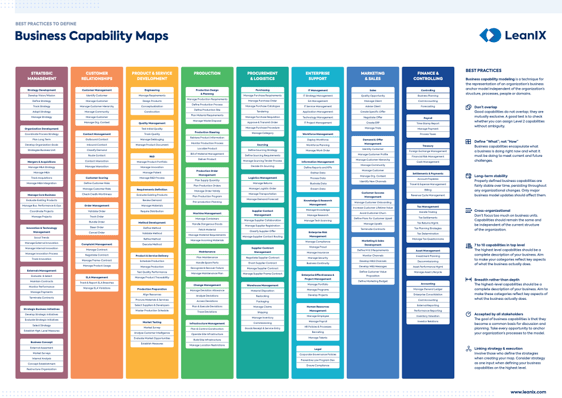Technical architect vs. solution architect vs. enterprise architect
With a technology landscape that evolves quickly, the roles of IT architects need to adapt as well. That’s why the distinction between the different types can sometimes become unclear. Even though tasks seem to overlap at times, each IT architect has their own area of responsibility.
While the enterprise architect focuses on the enterprise-level design of the IT landscape, solution architects are in charge of finding and introducing solutions to specific business problems. They also manage all activities that lead to the successful implementation of a new application.
Technical architects concentrate on one particular technology and provide the technological know-how that is needed to deliver the product.
The figure below illustrates the amount of strategic and technological input that each type of IT architect contributes to a project:
- Enterprise architects have a high strategy focus and less of a technology focus, while it is the other way around for technical architects.
- The solution architect bridges the gap between concept and implementation by acting as a channel between enterprise architecture and technical architecture.
📚 Related: Architecture Review Board
What are skillsets and responsibilities?
Enterprise architects need to have a variety of skills in order to become effective IT strategists. Next to having good knowledge of all enterprise software and technological trends, they also have to be skilled business managers.
They often interface with the executive leadership and need to be able to define and clearly communicate business goals in order to get stakeholders on board. It is their responsibility to align these business goals with the technological goals and the IT infrastructure of the organization. Most enterprise architects have a Master’s degree or an MBA.

Just like enterprise architects, solution architects need excellent communication skills. A lot of their time is spent coordinating ongoing activities and negotiating the needs of all involved parties. As the connecting piece between enterprise and technical architecture, they constantly move between different business layers.
Therefore, they must understand how all parts of the business work together. This requires a great deal of analytical thinking. As they are also in charge of ensuring the technical integrity of each solution, they are required to have a good understanding of technical specifics.
Technical architects are specialists in their field and need to be able to first visualize and then implement new technical concepts into an existing system. It is their responsibility to realize the IT project with a development team and define best practices and standards along the way.
Furthermore, they inform all parties involved about specific software requirements and associated risks. Ideally, technical architects are experienced in working with on-premise and cloud-native infrastructures and know-how to deploy an application most effectively.
What is the paid salary of an enterprise architect vs a solution or technical architect?
The salary for IT architects varies across the United States. On the lower end, the starting salary for all three types hovers around $82,000 a year. However, an average income of around $111,000 seems to be the norm.
According to Glassdoor, enterprise architects have the biggest earning potential. Senior or principal enterprise architects can make up to $135,000 a year. Right in the middle are solution architects who have the potential to receive an annual income of up to $116,000.
Technical architects tend to get the lowest rate out of the three. The average annual income of a specialized Java architect is indicated as $79,000.
What are the must-haves for a successful enterprise architect?
It is a combination of talents that makes a successful enterprise architect. Most importantly, they need to understand how the enterprise technology framework can lead to desired business goals. In this role, strategic and analytical thinking are just as important as outstanding soft skills.
The IT strategy development and architecture governance require an extremely structured work approach and the ability to choose and use special EAM tools. These tools help visualize roadmaps and keep track of all information related to a company’s IT architecture.
One of an enterprise architect’s greater talents is to analyze and synthesize this information through meta models and architecture diagrams that uncover operational gaps. In the same process, an enterprise architect evaluates possible applications in terms of integration and compliance with enterprise and business standards.
Enterprise architects also need to be comfortable with communicating the value of new IT strategies to the executive leadership team and stakeholders. In fact, a lot of their time is spent on people and decision-making processes.
Out of all IT architects, they are required to have the best grasp of the company’s IT landscape in relation to business outcomes. That is why this role requires a high level of awareness in regard to industry trends and enterprise-grade solutions that boost productivity and increase competitiveness.






/EN-WP-EA-Tomorrow-Resource_Page_Thumbnail.png?width=260&height=171&name=EN-WP-EA-Tomorrow-Resource_Page_Thumbnail.png)
/EN-TopStakeholderQuestions-Poster_Resource_Page_Thumbnail.png?width=260&height=171&name=EN-TopStakeholderQuestions-Poster_Resource_Page_Thumbnail.png)




